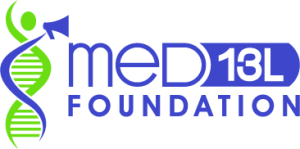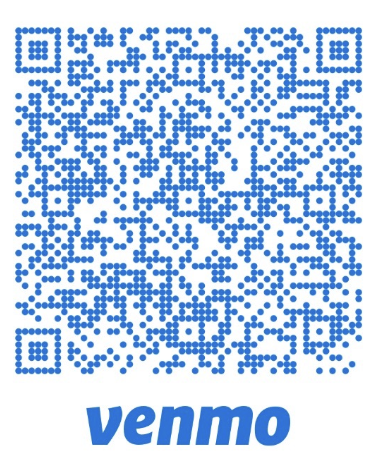What is MED13L?
MED13L syndrome is a neurodevelopmental genetic diagnosis characterized by intellectual disability (ID) speech impairment, and certain facial features (Adegbola et al. 2015). This diagnosis is relatively new as it was first described by Asadollahi et al. in 2017 with under 100 cases reported in the medical literature at this time.
MED13L Syndrome
MED13L syndrome is an autosomal dominant condition due to pathogenic changes (or mutations) in the MED13L gene which is located on chromosome 12. MED13L encodes part of the mediator complex which plays a critical role in how our genes are expressed (the levels at which genes are turned on and off in different cells and tissues) and how genetic instructions are used by our body. The MED13L gene was initially implicated as a cause of complex heart disease; however, with the characterization of MED13L-related intellectual disability syndrome we now know changes in this gene result in a broader clinical spectrum. The intellectual disability observed in affected individuals ranges from moderate to severe. All individuals have developmental delays with speech being most prominently affected. The common facial features observed most consistently across individuals with this diagnosis include macroglossia (enlarged tongue), macrostomia (wide mouth) and/or open mouth, low set ears, round nasal tip, and depressed/broad nasal bridge. Some additional features that can be observed in MED13L syndrome include hypotonia, cardiac defects, behavioral issues including autism, eye differences, as well as abnormalities of the hands and feet including flat feet, contractures, clinodactyly (slight curve to the 5th finger) and other foot deformities.
Genetics 101
Our bodies are made up of billions of cells and within each cell there are chromosomes which are the structures that hold all of our ~20,000 genes and genetic information. Genes function as the body’s instruction manual telling our body how to grow and develop. We have two copies of each gene as we get one set from our mothers and one set from our fathers. Genes are made up of genetic material, called DNA, and they serve as the blueprint from which proteins are made. Proteins are the basic building blocks of the human body performing specific functions so that our bodies work properly controlling everything from our heartbeat to determining our eye color (Figure 1).
Sometimes changes (or mutations) spontaneously occur in genes that prevent them from working properly altering the proteins that are made. As a result, this affects various bodily functions including growth and development.

What causes MED13L syndrome?
We all have two copies of every gene with one copy being inherited from our mother and one copy from our father. Some individuals can have a diagnosis of ME13L syndrome due to a specific change within the sequence of the gene, some can have larger deletions in which the entire MED13L gene or only part of the MED13L gene is missing and others can have a duplication involving part of the MED13L gene. In all of these cases, the typical function of the MED13L gene is disrupted.
The majority of individuals with this diagnosis will have an identified variant or genetic alteration within the sequence of the MED13L gene as opposed to a larger deletion or duplication. There are different types of sequence changes or mutations that can occur within a gene. A truncating (or frameshift) mutation is one type of mutation that tends to have a more significant effect on the gene that can ultimately block protein production. Missense mutations are a different type of mutation which generally only slightly changes the protein. In other diagnoses, missense mutations typically present with milder forms since their proteins likely retain some residual function. However, in MED13L syndrome those with missense mutations tend to frequently present with a more severe form of the diagnosis and can have absent speech, significantly delayed development of motor skills, seizures and other malformations (Smol et al. 2018). Therefore, it is hypothesized that missense mutations induce a dominant negative effect in which the mutated gene product not only loses its own function but also affects the function of the other non-mutated protein as well. This effect may explain why those with missense mutations have a more involved clinical picture (Tørring et al. 2018).
Can MED13L syndrome occur again in my family?
If both parents are clinically unaffected, then the risk for future affected children is estimated to be ~1%. This risk is above the general population’s risk due to the possibility of germline mosaicism. Germline mosaicism is a term to describe the situation in which all of the parents’ non-sperm or non-egg cells do NOT contain the mutation, but some of the egg or sperm cells DO contain the mutation and therefore, there is a risk to have another affected child.
If an indivudal with MED13L syndrome were to have children – they would have a 50% chance of passing on the gene change (since they have one MED13L gene with the change/mutation and one without).
Can I test future pregnancies?
References:
Adegbola A, Musante L, Callewaert B, Maciel P, Hu H, Isidor B, Picker-Minh S, Le Caignec C, Delle Chiaie B, Vanakker O, Menten B, Dheedene A, Bockaert N, Roelens F, Decaestecker K, Silva J, Soares G, Lopes F, Najmabadi H, Kahrizi K, Cox GF, Angus SP, Staropoli JF, Fischer U, Suckow V, Bartsch O, Chess A, Ropers HH, Wienker TF, Hübner C, Kaindl AM, Kalscheuer VM. Redefining the MED13L syndrome. Eur J Hum Genet. 2015 Oct;23(10):1308-17
Asadollahi R, Zweier M, Gogoll L, Schiffmann R, Sticht H, Steindl K, Rauch A. Genotype-phenotype evaluation of MED13L defects in the light of a novel truncating and a recurrent missense mutation. Eur J Med Genet. 2017 Sep;60(9):451-464.
Smol T, Petit F, Piton A, Keren B, Sanlaville D, Afenjar A, Baker S, Bedoukian EC, Bhoj EJ, Bonneau D, Boudry-Labis E, Bouquillon S, Boute-Benejean O, Caumes R, Chatron N, Colson C, Coubes C, Coutton C, Devillard F, Dieux-Coeslier A, Doco-Fenzy M, Ewans LJ, Faivre L, Fassi E, Field M, Fournier C, Francannet C, Genevieve D, Giurgea I, Goldenberg A, Green AK, Guerrot AM, Heron D, Isidor B, Keena BA, Krock BL, Kuentz P, Lapi E, Le Meur N, Lesca G, Li D, Marey I, Mignot C, Nava C, Nesbitt A, Nicolas G, Roche-Lestienne C, Roscioli T, Satre V, Santani A, Stefanova M, Steinwall Larsen S, Saugier-Veber P, Picker-Minh S, Thuillier C, Verloes A, Vieville G, Wenzel M, Willems M, Whalen S, Zarate YA, Ziegler A, Manouvrier-Hanu S, Kalscheuer VM, Gerard B, Ghoumid J. MED13L-related intellectual disability: involvement of missense variants and delineation of the phenotype. Neurogenetics. 2018 May;19(2):93-103.
Tørring PM, Larsen MJ, Brasch-Andersen C, Krogh LN, Kibæk M, Laulund L, Illum N, Dunkhase-Heinl U, Wiesener A, Popp B, Marangi G, Hjortshøj TD, Ek J, Vogel I, Becher N, Roos L, Zollino M, Fagerberg CR. Is MED13L-related intellectual disability a recognizable syndrome? Eur J Med Genet. 2018 Jun 27. pii: S1769-7212(18)30144-7
*This information was provided by Dr. Ian Krantz, geneticist, and Sarah Raible, genetic counselor, at the Children’s Hospital of Philadelphia.



